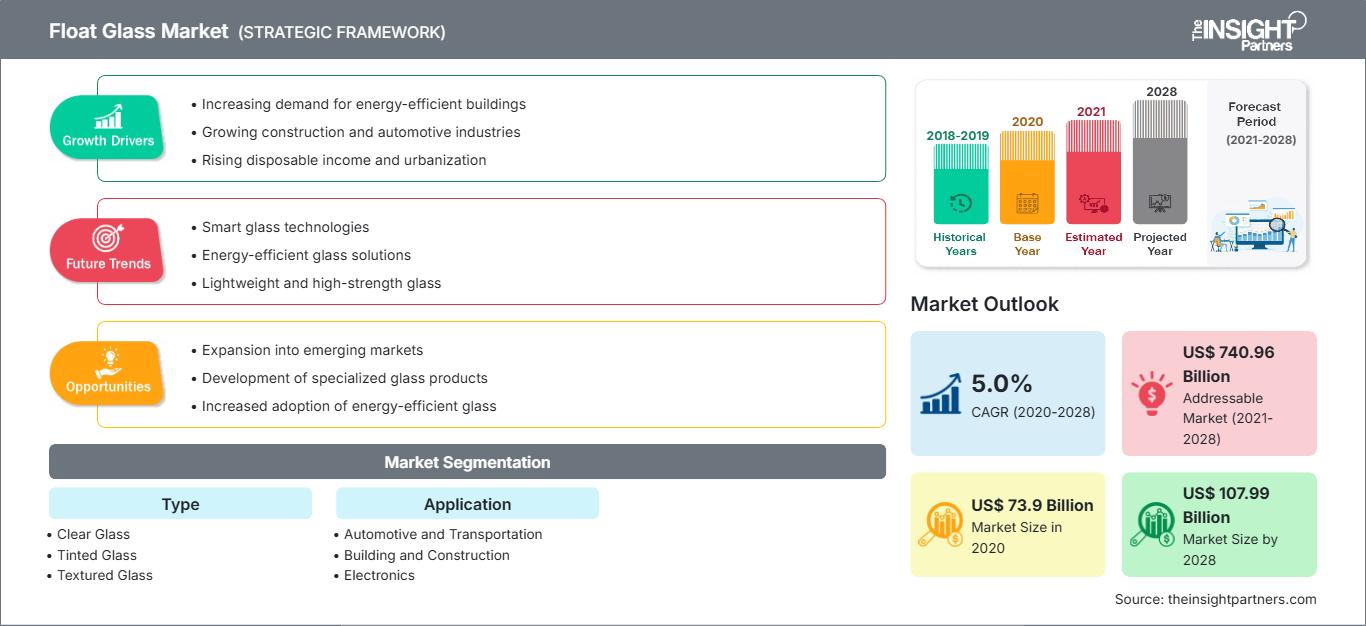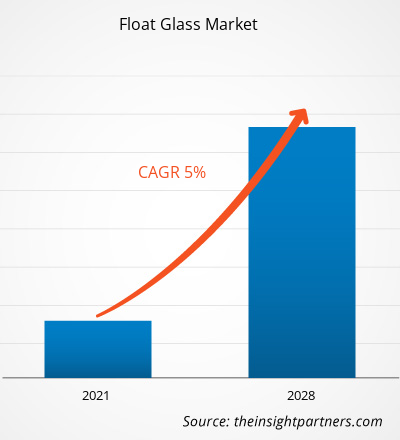Il mercato del vetro float è stato valutato a 73.897,83 milioni di dollari nel 2020 e si prevede che raggiungerà 1.07.991,35 milioni di dollari entro il 2028; si prevede una crescita a un CAGR del 5,0% dal 2021 al 2028.
Il vetro float è un vetro estremamente liscio e privo di distorsioni, utilizzato in vari settori industriali come l'edilizia, l'automotive, l'elettronica e l'energia solare, tra gli altri. Si ottiene fondamentalmente versando il vetro fuso dal forno in una camera contenente un letto di stagno fuso. L'aumento dell'uso del vetro float nell'interior design e nell'architettura moderna ha svolto un ruolo importante nell'aumento della domanda di questo materiale, che viene utilizzato in altre applicazioni edilizie, tra cui soffitti, pavimenti, vetri riflettenti, vetri rivestiti, finestre, specchi, piani di tavoli e vetri isolanti. Inoltre, si prevede che il crescente utilizzo del vetro float nelle applicazioni automobilistiche trainerà l'industria del vetro float nel periodo previsto.
Nel 2020, l'Asia-Pacifico ha rappresentato la quota maggiore del mercato globale del vetro float. Il crescente sviluppo del settore automobilistico e dell'edilizia sta trainando la domanda di vetro float nella regione. Anche l'ampio e consolidato settore automobilistico in paesi come Cina e India sta aumentando la domanda di vetro float in questi paesi. Parallelamente, lo sviluppo e la crescente penetrazione dell'industria solare nell'Asia-Pacifico stanno trainando la crescita del mercato del vetro float nella regione.
Personalizza questo rapporto in base alle tue esigenze
Potrai personalizzare gratuitamente qualsiasi rapporto, comprese parti di questo rapporto, o analisi a livello di paese, pacchetto dati Excel, oltre a usufruire di grandi offerte e sconti per start-up e università
Mercato del vetro float: Approfondimenti strategici

-
Ottieni le principali tendenze chiave del mercato di questo rapporto.Questo campione GRATUITO includerà l'analisi dei dati, che vanno dalle tendenze di mercato alle stime e alle previsioni.
La chiusura di vari stabilimenti produttivi e fabbriche in Nord America, Europa, Asia-Pacifico, Sud America e Medio Oriente e Africa a causa della pandemia di COVID-19 ha ostacolato la catena di fornitura globale e i processi di produzione, i tempi di consegna e le vendite dei prodotti. Inoltre, le restrizioni imposte dai paesi in Europa, Asia e Nord America stanno influenzando la collaborazione commerciale e le opportunità di partnership. L'attuale pandemia di COVID-19 ha avuto un impatto significativo sul mercato del vetro float. Le interruzioni nella produzione e nella catena di fornitura hanno avuto un impatto negativo sul mercato del vetro float. Si prevede che la carenza di vetro durerà fino al 2021, causando interruzioni in diverse attività. L'offerta di vetro si sta riducendo ed è diventata più costosa da acquistare a causa di vari fattori, tra cui la pandemia mondiale e i dazi doganali internazionali. A causa della pandemia globale, molte fabbriche e produttori hanno dovuto sospendere o rallentare la produzione di vetro, rendendo estremamente difficile soddisfare la domanda attuale. Riavviare le fabbriche dopo una chiusura o una produzione a basso livello per un periodo di tempo prolungato può essere estremamente impegnativo, soprattutto se le aziende non operano a piena capacità a causa delle normative in materia di salute e sicurezza. Inoltre, poiché la vaccinazione contro il COVID-19 è una priorità assoluta sia per il pubblico che per il settore sanitario, la disponibilità di vetro è stata reindirizzata alla causa che ha portato alla sua indisponibilità per altri settori, creando così una carenza di vetro sul mercato.
Approfondimenti di mercato
Aumento della domanda nel settore dell'edilizia e delle costruzioni
Il vetro float viene prodotto attraverso un processo di fusione, in cui vetro riciclato, calce, sabbia silicea, potassa e soda vengono fusi in un forno e fatti galleggiare su un letto di stagno fuso. Il vetro float è sempre più utilizzato nel settore dell'edilizia e delle costruzioni, che comprende i settori residenziale, commerciale e industriale. Il vetro float presenta un elevato grado di trasmissione luminosa, la capacità di produrre una vasta gamma di colori e opacità e una buona inerzia chimica, caratteristiche che ne hanno aumentato la domanda nel settore edile. Il vetro float viene utilizzato per finestre e porte nel settore residenziale, per applicazioni sia estetiche che funzionali. È inoltre sempre più utilizzato nell'interior design e nell'architettura moderna. Nel settore commerciale, il vetro float è richiesto in quanto offre una superficie esterna estetica e di facile manutenzione. Il vetro float offre elevata trasmissione luminosa e termica, influenzando la quantità di riscaldamento e raffreddamento richiesta all'interno di un edificio in base alle diverse stagioni e condizioni climatiche. Il vetro float viene utilizzato anche come vetrina nei punti vendita al dettaglio grazie alla sua trasparenza, durezza e facilità di pulizia. A causa della crescente attenzione all'ambiente, si è registrata una crescente domanda di vetro float nel settore edile, poiché contribuisce al conseguimento della certificazione LEED (Leadership in Energy and Environment Design) per edifici residenziali e commerciali. Si prevede che la crescente consapevolezza dei consumatori sulla sicurezza degli edifici e una maggiore attenzione al rispetto dei codici edilizi governativi aumenteranno ulteriormente la domanda di vetro float. Pertanto, la crescente domanda di vetro float da parte del settore edile e delle costruzioni alimenterà la crescita del mercato del vetro float durante il periodo di previsione.
Approfondimenti sulla tipologia
In base alla tipologia, il mercato del vetro float è segmentato in vetro trasparente, vetro colorato, vetro strutturato e altri. Il segmento del vetro trasparente ha detenuto la quota maggiore del mercato nel 2020. Il vetro trasparente è un vetro float, trasparente e privo di difetti e distorsioni ottiche. Il vetro float trasparente offre una qualità superiore rispetto ad altri tipi di vetro float grazie alle sue caratteristiche uniche, come una finitura superficiale migliorata, uno spessore uniforme, un'elevata qualità ottica, planarità e un aspetto brillante. Viene utilizzato in aree che richiedono elevata visibilità e chiarezza, come finestre, porte, specchi, serre, lucernari, elettrodomestici e solarium. Poiché il vetro trasparente è privo di distorsioni ottiche o piccoli difetti, consente una visione perfetta. Il vetro viene anche utilizzato per ulteriori lavorazioni per produrre altri tipi di vetro.
Alcuni dei principali attori del mercato che operano nel mercato del vetro float sono AGC Inc.; Nippon Sheet Glass Co., LTD (NSG Group); Xinyi Glass Holdings Limited; SCHOTT AG; Guardian Industries Holdings; Cardinal Glass Industries, Inc.; China Glass Holdings Limited; Shenzhen Sun Global Glass Co. Ltd.; Saint Gobain Glass India; e Qingdao Migo Glass Co. Ltd. I principali attori del mercato stanno adottando strategie come fusioni e acquisizioni e lanci di prodotti per espandere la presenza geografica e la base di consumatori.
Mercato del vetro floatLe tendenze regionali e i fattori che influenzano il mercato del vetro float durante il periodo di previsione sono stati ampiamente spiegati dagli analisti di The Insight Partners. Questa sezione analizza anche i segmenti e la geografia del mercato del vetro float in Nord America, Europa, Asia-Pacifico, Medio Oriente e Africa, America Meridionale e Centrale.
Ambito del rapporto sul mercato del vetro float
| Attributo del rapporto | Dettagli |
|---|---|
| Dimensioni del mercato in 2020 | US$ 73.9 Billion |
| Dimensioni del mercato per 2028 | US$ 107.99 Billion |
| CAGR globale (2020 - 2028) | 5.0% |
| Dati storici | 2018-2019 |
| Periodo di previsione | 2021-2028 |
| Segmenti coperti |
By Tipo
|
| Regioni e paesi coperti |
Nord America
|
| Leader di mercato e profili aziendali chiave |
|
Densità degli operatori del mercato del vetro float: comprendere il suo impatto sulle dinamiche aziendali
Il mercato del vetro float è in rapida crescita, trainato dalla crescente domanda da parte degli utenti finali, dovuta a fattori quali l'evoluzione delle preferenze dei consumatori, i progressi tecnologici e una maggiore consapevolezza dei vantaggi del prodotto. Con l'aumento della domanda, le aziende stanno ampliando la propria offerta, innovando per soddisfare le esigenze dei consumatori e sfruttando le tendenze emergenti, alimentando ulteriormente la crescita del mercato.

- Ottieni il Mercato del vetro float Panoramica dei principali attori chiave
In evidenza nel rapporto
- Tendenze progressive nel settore del vetro float per aiutare gli operatori a sviluppare strategie efficaci a lungo termine
- Strategie di crescita aziendale adottate dalle aziende per garantire la crescita nei mercati sviluppati e in via di sviluppo
- Analisi quantitativa del mercato globale del vetro float dal 2019 al 2028
- Stima della domanda di vetro float in vari settori
- Analisi di Porter per illustrare l'efficacia di acquirenti e fornitori che operano nel settore per prevedere la crescita del mercato
- Sviluppi recenti per comprendere lo scenario competitivo del mercato e la domanda di vetro float
- Tendenze e prospettive di mercato insieme ai fattori che guidano e frenano la crescita del mercato del vetro float
- Comprensione delle strategie che sostengono l'interesse commerciale per quanto riguarda la crescita del mercato globale del vetro float, aiutando nel processo decisionale
- Dimensioni del mercato del vetro float in vari nodi di mercato
- Panoramica dettagliata e segmentazione del mercato globale del vetro float, nonché dinamiche del suo settore
- Dimensioni del mercato del vetro float in varie regioni con promettenti opportunità di crescita
Mercato del vetro float, per tipo
- Vetro trasparente
- Vetro colorato
- Vetro testurizzato
- Altri
Mercato del vetro float, per applicazione
- Automotive e trasporti
- Edilizia e costruzioni
- Elettronica
- Altri
Profili aziendali
- AGC Inc.
- Nippon Sheet Glass Co., LTD (NSG Group)
- Xinyi Glass Holdings Limited
- SCHOTT AG
- Guardian Industries Holdings
- Cardinal Glass Industries, Inc.
- China Glass Holdings Limited
- Shenzhen Sun Global Glass Co. Ltd.
- Saint Gobain Glass India
- Qingdao Migo Glass Co. Ltd
- Analisi storica (2 anni), anno base, previsione (7 anni) con CAGR
- Analisi PEST e SWOT
- Valore/volume delle dimensioni del mercato - Globale, Regionale, Nazionale
- Industria e panorama competitivo
- Set di dati Excel
Report recenti
Rapporti correlati
Testimonianze
Motivo dell'acquisto
- Processo decisionale informato
- Comprensione delle dinamiche di mercato
- Analisi competitiva
- Analisi dei clienti
- Previsioni di mercato
- Mitigazione del rischio
- Pianificazione strategica
- Giustificazione degli investimenti
- Identificazione dei mercati emergenti
- Miglioramento delle strategie di marketing
- Aumento dell'efficienza operativa
- Allineamento alle tendenze normative






















 Ottieni un campione gratuito per - Mercato del vetro float
Ottieni un campione gratuito per - Mercato del vetro float